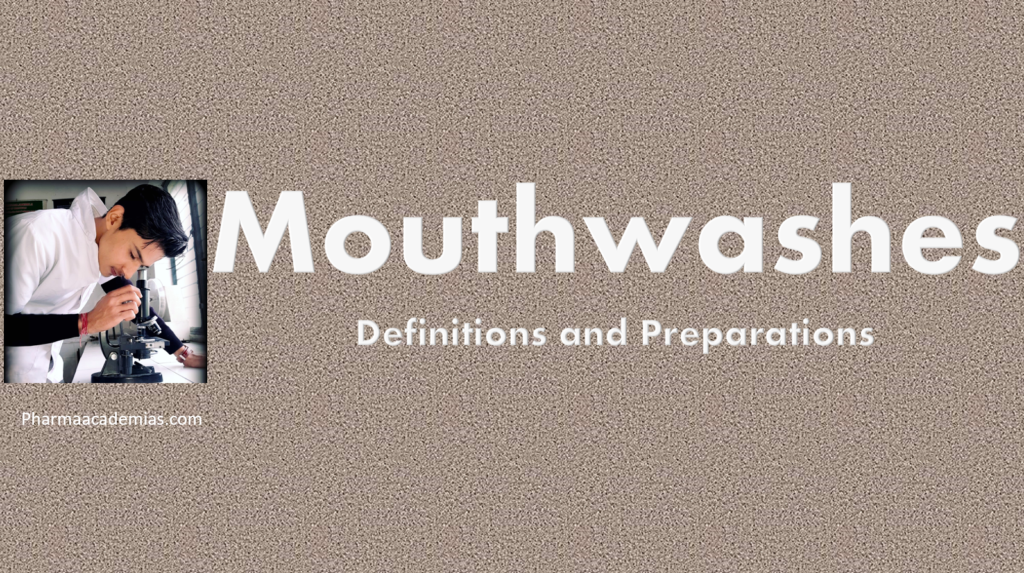1. Definition
Mouthwashes, or oral or mouth rinses, are liquid solutions for cleaning and freshening the mouth. They are a part of oral hygiene practices and can serve various purposes, including reducing plaque, fighting bacteria, preventing gum disease, and providing a refreshing sensation.
2. Types of Mouthwashes
a. Antiseptic Mouthwashes:
– Contains antimicrobial agents like chlorhexidine or cetylpyridinium chloride.
– Effective against bacteria, reducing plaque and gingivitis.
– Used for therapeutic purposes in treating oral infections.
b. Fluoride Mouthwashes:
– Contains fluoride, which helps prevent tooth decay by strengthening enamel.
– Often recommended for individuals at high risk of cavities.
c. Cosmetic Mouthwashes:
– Primarily for breath freshening and a pleasant taste.
– May not have therapeutic benefits like reducing bacteria or preventing cavities.
d. Natural or Herbal Mouthwashes:
– Utilizes natural ingredients like tea tree oil, aloe vera, or herbal extracts.
– May offer antibacterial properties and fresh breath without synthetic additives.
3. Ingredients in Mouthwashes
a. Antimicrobial Agents:
– Chlorhexidine, cetylpyridinium chloride, and essential oils (e.g., eucalyptus or tea tree oil).
b. Fluoride Compounds:
– Sodium fluoride, stannous fluoride, or sodium monofluorophosphate.
c. Astringents:
– Tannic acid or zinc chloride, which can help tighten oral tissues.
d. Humectants:
– Glycerin or sorbitol, which retains moisture and prevents the mouthwash from drying out.
e. Flavoring Agents:
– Mint, spearmint, peppermint, or other flavorings for a pleasant taste.
f. Sweeteners:
– Saccharin or xylitol for sweetness without promoting tooth decay.
g. Coloring Agents:
– Generally added for cosmetic reasons to enhance product appearance.
4. Preparation of Mouthwashes
a. Antiseptic Mouthwash:
– Mix specified amounts of chlorhexidine or cetylpyridinium chloride with water.
– Add flavorings, sweeteners, and colorings according to the desired taste and appearance.
b. Fluoride Mouthwash:
– Dissolve the appropriate fluoride compound in water.
– Adjust the concentration to meet recommended fluoride levels.
– Add flavorings, sweeteners, and colorings as necessary.
c. Cosmetic Mouthwash:
– Blend water with flavorings, sweeteners, and colorings for a refreshing and pleasant taste.
– May contain minimal or no therapeutic agents.
d. Natural or Herbal Mouthwash:
– Infuse water with herbal extracts or essential oils known for their oral health benefits.
– Balance with flavorings, sweeteners, and colorings for an appealing product.
5. Usage and Recommendations
a. Frequency:
– Follow product instructions for frequency of use.
– Typically, mouthwashes are used once or twice daily.
b. Duration:
– Rinse for the recommended time (usually 30 seconds to 1 minute) before spitting out the mouthwash.
c. Caution:
– Avoid swallowing mouthwash, especially if it contains high fluoride levels or other potentially harmful ingredients.
– Consult with a dentist or healthcare professional for personalized recommendations.
mouthwashes are crucial in oral hygiene, and their formulations vary based on intended use. The choice from antiseptic to cosmetic mouthwashes depends on individual oral health needs and preferences. Regular and proper use and other oral care practices contribute to maintaining a healthy and fresh mouth.




